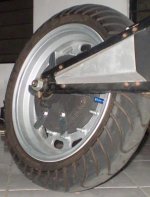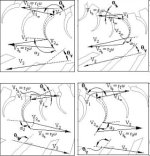John in CR
100 TW
fellow said:Sooner or later we must accept motorcycle cooling soulutions (big radiator, fluid cooling) as the only way of getting into the 10+ kW terrirory.
That would be true if our motors weren't drastically more efficient than ICE's. Zero emotos run at 40kw output and those motors are passively air cooled, and for high demand racing people simply add an inexpensive and lightweight blower to force a high velocity flow over the outer shell. I run my hubmotor at 27kw peak with a simple bladed through motor ventilation approach.
The guys running the oil bath approach have demonstrated that it's superior to the liquid cooling approaches that don't put the coolant in direct contact with the copper and stator steel, because it eliminates the temperature spikes of intermittent use by moving the heat away from the copper more quickly resulting in a more homogeneous temperature throughout the motor. They've come up with some novel ways to all but eliminate oil leakage.
What baffles me though is that the final step in heat transfer is completely ignored due to the simple fact that by leaving the exterior unchanged the only way the motor can dissipate more heat is if the exterior shell of the hubmotor is hotter than without the oil. Anyone who has run a hubmotor in stock form knows the outside shell can get very hot. I asked too much of my first hubmotor and pushed it to near failure, and when I sprayed it with water it sizzled away quickly. Sure the oil bath heats the shell more quickly, so early in a ride it dissipates more heat, but the ultimate bottleneck for heat transfer remains unchanged. The gains from having more heat dissipation early and having a more homogenous motor temperature (which also increases efficiency a bit due to lower copper resistance) may be enough for guys like Emmett who run modest power, but most of them would see bigger gains from proper controller tuning (another all but ignored factor in keeping motors cooler), and many, if not a majority, want to push well beyond 3-4kw with their hubmotors.
Hubmotor covers are mostly smooth, which reflects how clueless the manufacturers are when it comes to heat transfer. That leaves the door wide open for large improvement. I'm not talking necessarily adding lots of large heat sink fins to the covers, though I'd probably go that route if I had aluminum welding capability. Normal operation means we have a natural forced air flow, so cutting small closely spaced channels should be able net double the surface area without impacting the structural integrity of the covers as long as you don't get carried away too much near the center. For good measure I'd add a handful of blades at the perimeter to induce much more air flow from the center like I saw with a smoke test of my ventilated air cooling approach that includes exterior blades.
Note that if you increase the surface area of the interior of the covers in a similar manner, it will net significant gains in heat transfer for a motor without oil fill, especially if you include interior blades that increase the turbulence and flow velocity of the air at the stator and end windings. It wouldn't net the homogenous motor temperature benefits like oil fill does, so there would still be temperature spikes in the copper, but stock hubbies dissipate heat amazingly well considering the layer of air between the stator and shell, and this change would significantly improve upon that. I'm working with a motor manufacturer to incorporate these ideas in the motor shell and covers, and we're expecting to be able to increase motor power by 30-40% on the scooters they produce.
John




